- Complete Guide to (57) Almost All Types of Fiber Arts with Photos
- What is Sheep’s wool used for? 53 Great Possibilities
- Yay! the 1 Best Answer to – define the term, fiber. name the four techniques of art that use fiber.
- What is considered fiber art? Expert Answer 5 Little-known Factors
- Mastering Art: How To Make Fabric From Fiber, A Comprehensive Guide
- The Ultimate Encyclopedia of Animal Fiber: Everything You Need to Know
What is sheep wool used for? What a great question!
It looked hot inside the dually and I could tell that the kids inside, neither older than seven, were getting restless. The sheep farmer drew our attention to the trailer filled with what must have been 50 good looking suffolk fleeces. They had been shorn and prepared for a selling pool that at the last minute didn’t happen, so he had brought them to my handspinners guild, not knowing where else to take them. One thing was obvious, he hated the idea of them, and his hard work, going to waste and I don’t blame him.
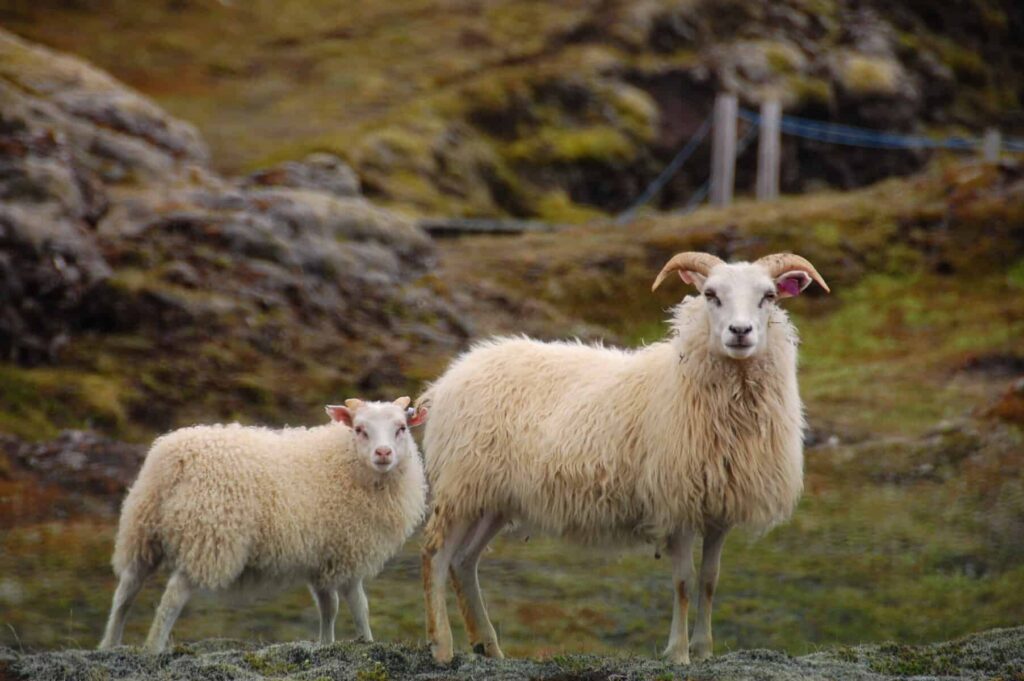
What is sheep’s wool used for? It’s a good question. Not long after sheep were first domesticated around 7,000 years ago, their wool became a building block of civilization. Wool’s unique properties have made it an incredibly versatile material with applications ranging from traditional textiles to modern machining innovations.
While this load of fleeces was way more than my guild could handle at the drop of a hat, in a modern processing mill this would be short work. But then what? You may wonder. You say you don’t wear wool? Too itchy? Let’s delve into the many uses of wool, brush up on a little history and see how amazing this sustainable fiber is.
So we have some wool and we’re not sure what to do with it. When considering the use of wool, our first question should be what kind of sheep are we shearing? There are lots of different sheep breeds, and they have different kinds of wool.
Sheep are bred for a variety of characteristics. Sheep which are bred for their wool, like say merino wool sheep, can have fiber that is classified as coarse, medium, fine, long and crossbred. Hint – If it’s a merino sheep it’s always fine. And each of those textures are good for different things.
Fine wool is great close to the skin. If it’s also beautifully dyed, it might even provoke a fight in the right knitting circle. Coarse wool, like from Churro sheep, on the other hand, could be just what you need to make a woven rug. Some wool can also be kempy, weak or in terrible shape. So there is a lot to think about.
After that consideration, wool can be treated with any one of the following four stages of processing: raw, minimally processed, spun, and felted. Wool can be useful in any of these stages. How any given fleece ends up being used depends on its overall quality, balanced against the effort further processing will take.
So let’s take a look at some of the many things you can do with a truck load of wool, or maybe even just one fleece, if you’re so inclined.
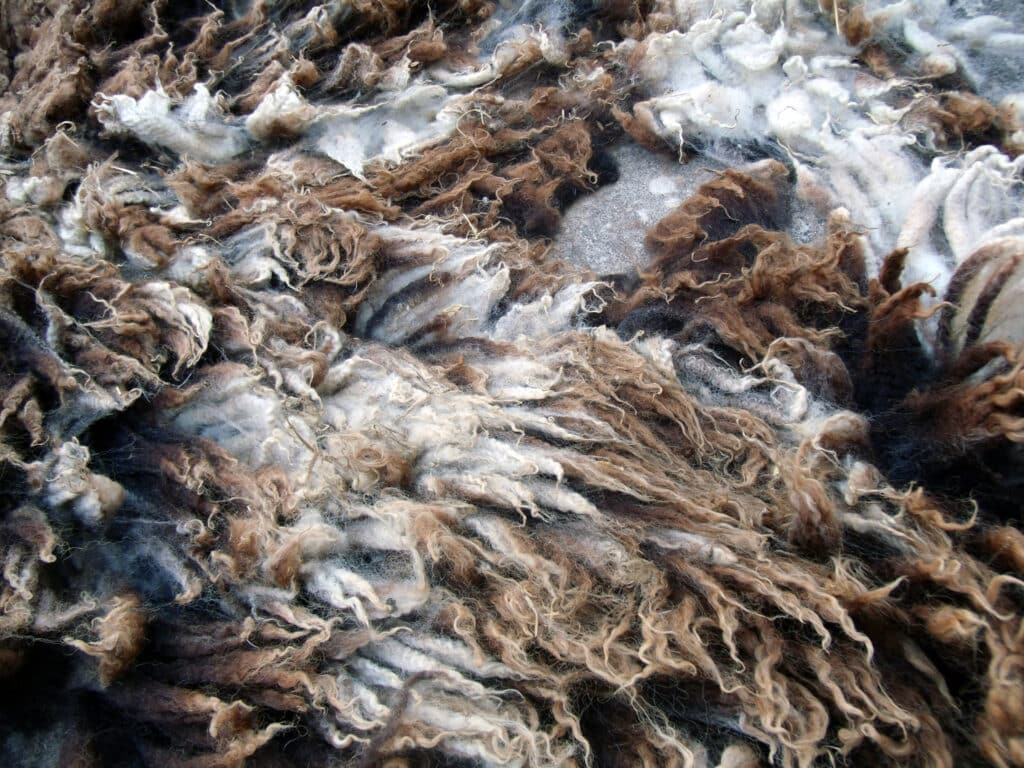
Uses of Raw Wool
A raw wool fleece is, on average, one year’s worth of growth of any given sheep. Since most domesticated sheep don’t shed their wool, their fiber must be shorn from them at least on a yearly basis. They are like the poodles of farm animals.
Depending on the breed of sheep, the condition of the raw fleece can be anywhere from quite dirty with lots of vegetable matter, to almost completely clean except for the presence of lanolin, or wool wax. Breeds with very fine wool, like merino sheep, are often coated to protect the fiber.
Raw fleece that’s very soiled, discolored, kempy, coarse or weakened due to the sheep being stressed, can still be put to a variety of uses. Without even so much as washing, you can use a raw fleece as mulch, bird nesting material, compost, Flower Basket lining, fertilizer, and cleaner.
- Mulch. Wool’s natural ability to hold and wick moisture also happened to make wool mulch an excellent choice for stopping weeds and protecting plants. Used around the base of plants, the thick matted nature of raw wool can effectively reduce weeds growth. At the same time, the structure of the wool can hold a significant amount of moisture without becoming soaked. This is perfect for plants in dry areas that need more consistent access to water.
- Nesting material. In the wild, birds naturally collect the shed hair of other animals to line their nests. Wool left out in a cage style dispenser will be quickly collected by birds. The birds will then use this wool when creating their spring nests.
- Compost. Raw wool also makes an excellent addition to compost. Used as a brown (good composting divides materials into greens and browns), sheep’s wool biodegrades slowly. Containing both nitrogen and potassium sheep wool enriches compost. At the same time its ability to retain water allows for continued microbe growth which is an essential part of good composting. But that’s another article.
- Flower basket lining. It’s these same qualities, which also makes raw wool a good alternative to coir fiber when lining a basket for a hanging plant. When placed within the basin of a hanging wire basket, the wool effectively contains the soil needed to grow the flowers while also holding together along the exterior. In addition it provides extra insurance in holding water for the plants and acts as non-burning slow release fertilizer over time.
- Fertilizer. It should be no surprise that with all these great qualities raw fleece also makes an excellent fertilizer just by itself. It can be mixed directly into the soil where it can hold water and slowly decay releasing its nitrogen, potassium and trace minerals. This is an especially effective application for the waste edges from a skirted fleece which may be soiled with urine or manure. To take this even further wool pellets are now available just for this purpose.
- Cleaning. A recent study published in The Journal of Natural Fibers, suggests that raw wool may also be an excellent cleaner and absorber. It is hypothesized that the same large pores which allow wool to absorb dye may also effectively absorb other things like oil spills. Wool has also been proven to remove crude, vegetable, diesel fuel, base, and motor oil; it can also effectively absorb both silver and copper from industrial wastewaters.
Wool also absorbs VOCs from indoor air like suspected carcinogens, dodecane and formaldehyde, but you might want to wash it first for that. Which brings us to minimal processing.
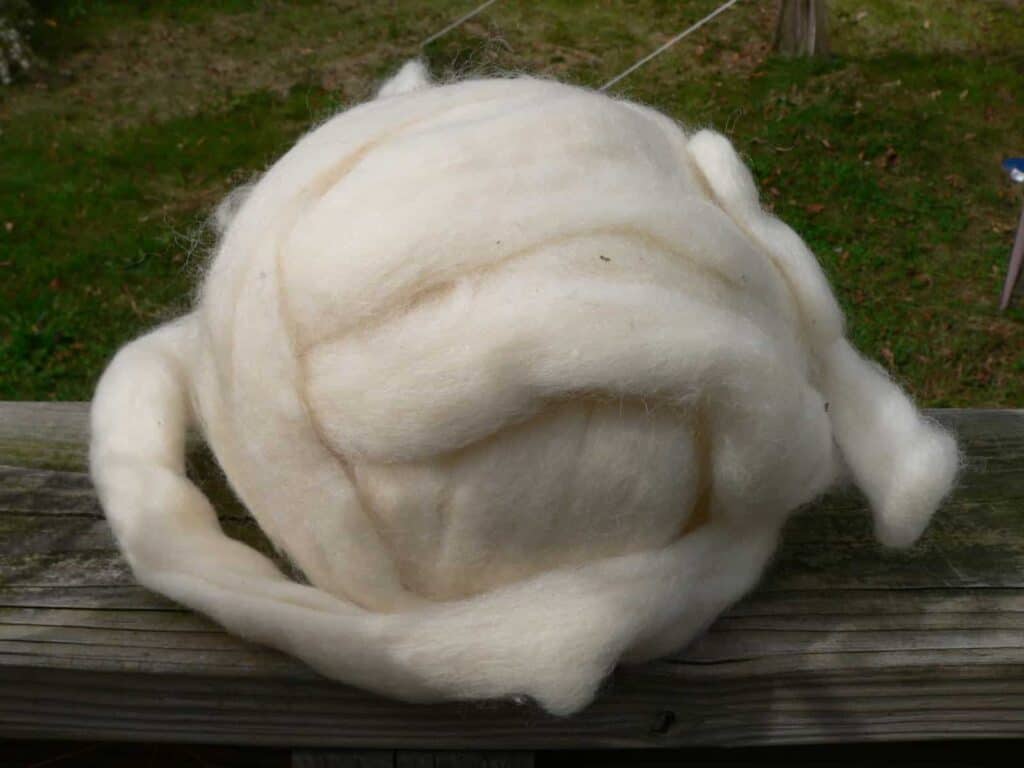
Uses of Minimally Processed Wool
Processing wool, washing with hot water, carding, and combing, opens up many more wool products as possible uses for a fleece. Because wool comes from sheep there is always the need to clean and prepare it for uses where it’s intended to last a little while and not smell like a barnyard.
In the farm setting a raw fleece can be soiled with manure or urine and if uncoated, can pick up a significant amount of vegetable matter from hay and other sources. Sheep also produce lanolin, a thick waxy oil that lubricates their skin. Lanolin, sometimes called wool wax, has a strong odor. Until it’s washed away with lots of hot water and soap, the presence of lanolin limits how a fleece can be used.
The most minimal processing step, washing, clears a fleece of lanolin and a significant amount of dirt and vegetable matter. To really extend the usability of wool the additional step of picking and carding makes wool suitable for a number of other uses. We will discuss seven of those uses.
- Bedding. While it is less common today, using sheep wool for different bedding functions has been done since ancient Rome. prior to the dominance of cotton and other synthetic fibers wool was often used for things like filling comforters or pillows. Today wool is making a comeback in those areas. Wool’s resistance to fire, microbes and dust mites make it a great choice for bedding fill.
- Furniture stuffing. Along those same lines, processed wool can make a resilient fill for upholstery and throw pillows. Again wool’s fire resistant properties and long wearing durability make it a good choice for padding inside stuffed furniture.
- Craft Material. Outside of knitting and crochet, processed wool can also be used as a basic craft material. Curly locks for example make excellent doll hair. Cleaned wool can also be felted into balls and then used as jewelry or as elements on a garland. The possibilities are endless!
- Lanolin. Going at it from another angle, when you process wool you can collect the lanolin or wool wax. Lanolin makes an excellent lotion and skin protectant. It can also be mixed in with other preparations made to improve skin health.
- Industrial cleaning. Wool can also work as a fire resistant, absorbent material to soak up things like oil spills. While I’ve pointed this out before, when wool has been cleaned and prepared for storage, it’s a much more practical solution to this problem.
- Insulation. Wool can also be used as an insulation material. In the past clean wool was sometimes used inside walls for its warmth retaining properties. Today wool insulation is making a comeback, if on a small scale. Wool naturally resists mold and Fire. It absorbs moisture in a way that will regulate humidity without ever feeling wet. It resists breakage and has elasticity making it durable for a long time. Wool insulation is excellent at retaining heat or cool while also providing good sound dampening. If that wasn’t enough, it’s also a natural fiber.
- Packing material. For the same reasons that makes an excellent insulator it can also function as a natural packing material. It’s endlessly reusable for this function and can be compressed for storage unlike packing peanuts or bubble wrap.
Uses of spun wool
When most people think of wool they think of its uses as a spun fiber. And once wool has been washed and processed it can be spun and then used in a variety of ways. Depending on the texture of the wool, coarse wools being well suited to making carpets and fine wools being better suited to garments close to the skin, it can be put to good use after spinning.
Spinning is a process that twists the fibers together while simultaneously stretching out the wool and creating a yarn or thread. This process both makes the wool more durable while it also expands its uses as it can then be crafted into a fabric. Some of the spun uses of wool include the following:
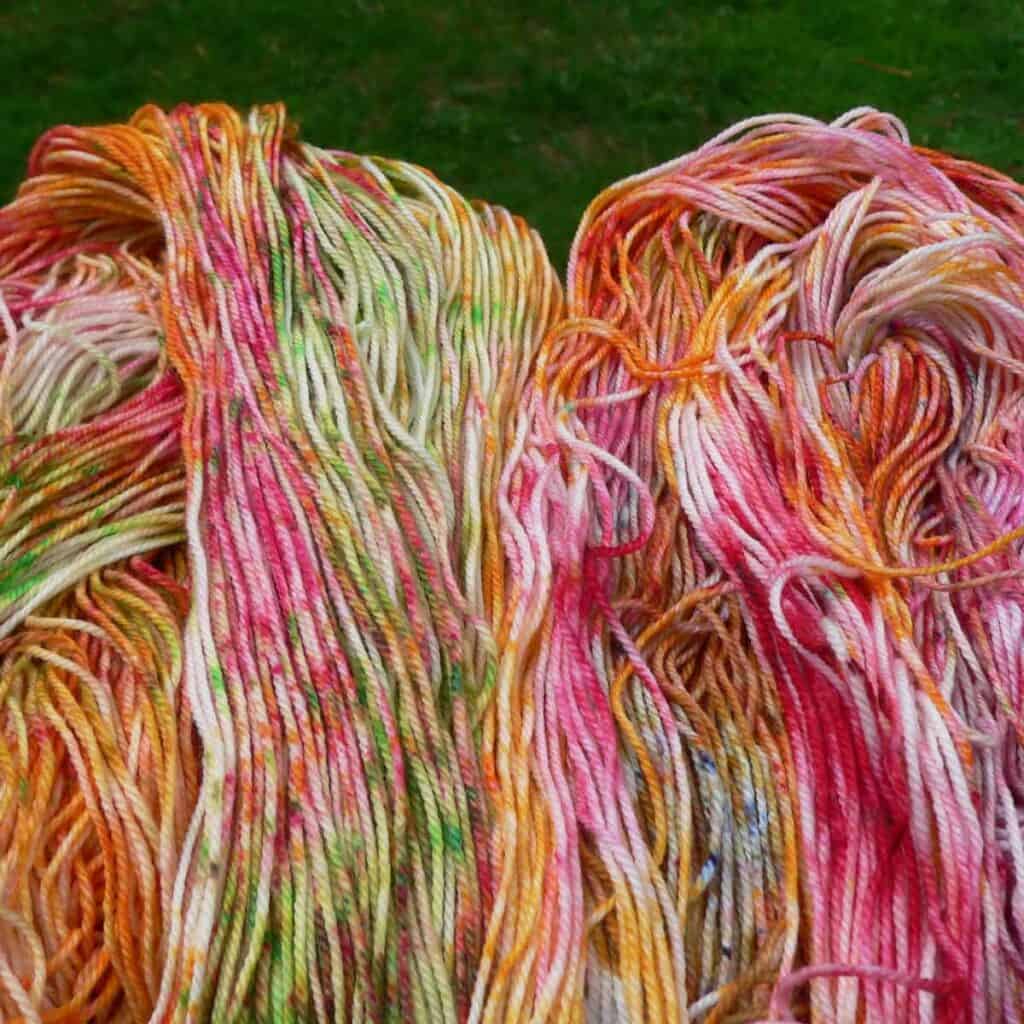
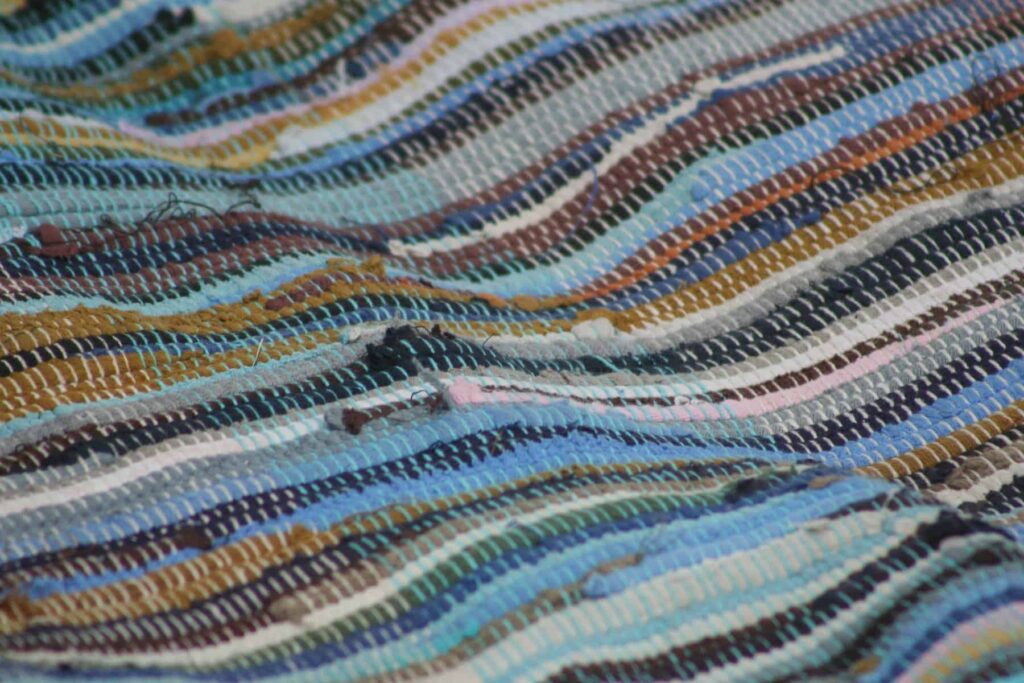
- Houseware textiles. The most common form would be as upholstery fabric. Heavyweight wool fabric would be a durable choice to cover any sofa or chair and it would still have all of the other great benefits of wool like fire resistance, resisting mold and being it all around great natural fiber. Wool also makes for excellent curtains.
- Hobby wool yarn. For all those knitters and crocheters out there this one’s for you. Vast amounts of wool yarn is made every year and it’s always a great choice particularly if you have Merino or other fine wool she breeds. As a hand spinner and a knitter this may be my favorite use of wool.
- Carpet yarn. You could probably also include blankets in this, but coarse wool yarn for carpeting is an excellent use. The more robust fiber breeds, like churro, make for exceptionally long-lasting carpet.
- Clothing fabric. Garment manufacture is by far the most well-known use of wool. Making wool clothes is a traditional use which goes back at least to ancient Rome. Prior to the invention of the cotton gin and the development of synthetic fiber, wool was the most common fiber used for clothing for most people. Who doesn’t love a wool slipper? Today wool is likely to be used to make one of the following garments:
- Hats. whether knitted or crocheted this is a great use, especially for a small amount of fiber.
- Suiting. A fine suit is still in, and when it’s made of wool it’s breathable. Wool can be comfortable in a variety of temperatures and if you happen to fumble your cigar, wool is unlikely to catch fire and it won’t melt. That’s why every year miles of fine wool is made into suiting.
- Skirts and pants. If you have the nice blazer, you’re going to want the matching skirt or trousers. This is just being thorough.
- Sweaters. This is the choice of more industrious knitters and crocheters, and it’s also a staple of the modern fashion world. Some fibers types, like merino wool are especially desired for sweater making. Most folks would probably think of sweaters as the goto answer for what is sheep wool used for, but you know what? That still counts.
- Outerwear. Letterman jackets are still a thing. So are pea coats. This is wool’s wheelhouse. There is a reason this tradition and history will keep us in wool.
- Fire resistant clothing. A novel use and a good one. Recent studies have shown that wool performed the best as a protective clothing for military personnel and first responders as a base layer. Think underwear. When confronting improvised explosive devices (IEDs) synthetic fiber can melt leading to more severe skin injuries. Merino is comfortable close to the skin, and it won’t melt. Hallelujah.
- High performance athletic gear. Wool is odor absorbent. Now that might sound bad at first, but what that means is that it traps bad odors so well you don’t smell them. This is nice because it also means you don’t have to launder your wool gear as often. What makes this use possible in part is merino sheep and other fine wool breeds with wool soft enough to be comfortable right next to the skin. So break out wool winter bike shorts, socks and work out gear. Most of this wool has been treated so that it won’t felt, so that makes for worry free washing as well.
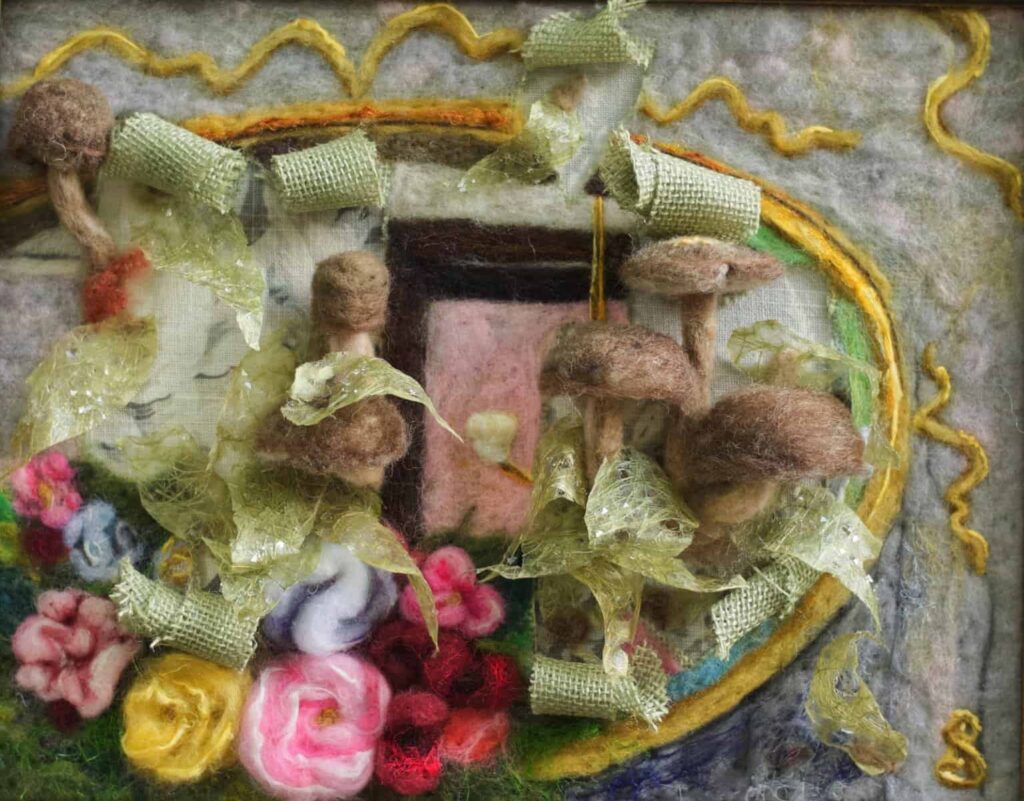
Uses of Felted Wool
I suspect that our sheep farmer friend with the truckload of Suffolk wool, would have quickly exhausted his supply with the wool projects I’ve already listed, had he been able to easily drop off his trailer load at the right wool processing mill.
Say he had another 10 trucks, he might have enough for some of the many felted uses (though Suffolk wool must be needle felted) of wool. Even as a felt artist I had no idea how many jobs there were for felted wool until I started looking around. I’m sure this list isn’t exhaustive, but it is pretty incredible. Check out what felted wool can do.
- Dryer balls. I’m sure you’ve seen them, right? It was in part thinking about dryer balls that got me here. I believe they must have started as a novel use of the by-products of industrial felt making. (Wet felting often leaves behind balls.) While I still can’t confirm this, dryer balls have become wildly popular and do seem to fluff the laundry up a bit.
When felted into a sheet of fabric, this is where wool really takes off. We’ll start with the usual suspects and go from there.
- Crafts. Craft felt, you know it, and probably love it. It has a wonderfully long rap sheet of being used for kids felt story boards, or really quick stuffed animal repairs. Let your imagination run wild. In pre-felt form I use it in some of my wool paintings even.
- Quilt pressing mat. If you are a quilter, you know the challenge of trying to iron your pieces to get nice crisp seams. I don’t know why these work better than ironing boards, but they do. It’s also pretty nice that you can drop it anywhere, like say on your table, and iron away without worrying about damage below when you’re using dry heat.
Wool garments. There are a few surprises here, so I’ll go through them one by one.
- Coats. While a lot of wool coats, like pea coats, are woven and then boiled or fulled, some are simply felted. There are pros and cons to each process. In both cases the upshot is the same. A darn nice coat.
- Shoes. When I lived up in Alaska one of the coolest things I saw was was the Norwegian Lobben boots. Pure felt, no left or right shaping, and plenty warm all winter long. In Alaska. Even in the sled dog races. There are also slippers and Birkenstocks. I miss the snow now.
- Insoles. You don’t always need a full boot. Sometimes what you need is an insole. Wool felt works great for that, and what’s nice is that it will shape to your foot and is durable.
- Hats. Today’s felt hats are often made with wool. It’s straightforward enough that you can even do this at home. More elaborate wool felt hats can be made with shaper and hat forms.
- Handbags. That’s right. Felt makes a study handbag and it can be embellished with needle felting, embroidery or other fiber arts.
- Embroidery backing. Specifically for patches, wool felt is occasionally pressed into service to make the embroidered fabric more robust holding together as a patch. Who knew?
Musical Instruments. John Coltrane, Charlie Parker, Emmanuel Pahud, you know what they have in common? A debt to wool.
- Woodwind Pads. Under the little keys in many woodwind instruments are leather covered felt pads. The sound dampening and sealant qualities of wool are put to good use here in creating covers that can be opened and closed to alter the sound of the instruments.
- Piano joints. Functioning a bit like gaskets and seals, wool felt is a hard working part in the guts of pianos. Strategically placed, wool felt assures that the moving parts don’t click or scrape as they move and the only sound coming from the instrument is the delightful hum of the strings.
- Mallets. Wool is also used to make the mallet heads for a number of percussion instruments from timpanis to xylophones. Who knew wool sounded so good?
Industrial uses. Wool felt use in industry surprised me. When I stopped to think about it, it made sense. It’s easy to shape. It will hold its shape. You can build it up to a very thick mat if you want to. It resists fire, doesn’t melt, and manages humidity well. I was amazed. Maybe you will be too.
- Gaskets. That’s right, wool felt makes for an excellent gasket and has been used that way for a long time. Wool’s resilience helps it absorb movement and reduce rattles and squeaks. Wool fibers also hold oil and that can trap small particles. This makes for good filtration. In other places wool gaskets holding oil can be great lubricators. The nature of the fiber can also block dust. Amazing, right?!
- Seals. In the same way wool felt can also be a seal. A seal is a lot like a gasket. The big difference is that a gasket works as a non-moving sealer between two flat surfaces, where a full on seal has to function in a more dynamic environment like on rotating shafts or between engine parts. Check your windows, wool pile is used as a seal on some windows to keep bugs out and your air in. What’s especially nice about this is that unlike rubber seal, wool won’t peel, crack or take on a distorted shape. Nice huh?
- Packing. That’s right. Wool felt makes excellent protection for you precious items either when you’re moving or shipping things. Felt blankets can protect furniture in a moving truck and felt inserts can keep fine china from breaking when you have to move out in the middle of the night. It’s a bit more pricey than styrofoam so you don’t see it used for commercial packing much outside of furniture blankets, but it sure could be. It’s something to consider if you ever have to ship great grandpa’s ashes.
- Rug or carpet padding. Did you know that wool could be used for carpet padding in addition to being the carpet? It’s true. This is another one of those hidden (literally) uses that you might not think about unless you are currently putting in new carpet. But it just happens to be a fine use of fleece that’s not sweater material.
- Anti-vibration. Have you ever noticed how car commercials talk about how quiet it is inside the car? Well you can thank wool felt and its sound absorbing qualities for some of this. Just like you use padding under carpet in your house, car manufacturers use wool felt padding under the carpet in your car to absorb sound and overall limit the vibrations that cause weird rattles often joked about on Car Talk. Wool is great for this because it lasts longer than synthetic materials while staying resilient.
- Sound buffering. Along those same lines, wool felt is used on speakers for the same reason.
- Seat pads. Aside from where sheepskin is used as a cover, wool’s fire resistance, lightweight, ability to comfortably manage temperature in both the heat and the cold, and durability have made it a popular choice when quality and comfort are the priority. This could also be a great weekend felt project for folks that just want to soften up plastic or wooden chairs.
- Car wash scrubbers. Used for either washing or buffing. Deep wool pile draws up dirt and keeps it from damaging the paint work.
- Floor mats. For the same reason wool makes great carpet and rugs, it can also be used for car floor mats.
Housewares. Wool felt finds its way into some other surprising house bound functions.
- Ironing board padding. Just as wool felt works well as a quilting mat, it can also be a workhorse in your ironing board. Heat tolerant and moisture controlling, this is a great use of wool felt.
- Door bumpers. Have you ever used a small felt disc to keep your cabinet door from hitting the frame too hard? You may have been using a little bit of wool felt.
- Furniture Sliders. Have you ever used a small felt disc on the bottom of your kitchen chairs so they would be quieter and easier to slide under the table? That’s right, those can be wool felt too.
- Picture spaces. Along the same lines, using little discs of wool to hold the frame of a piece of artwork above the wall, so they don’t move as much or leave marks on the wall, another great job for wool
Sporting Goods. Wool hides in a number of different places and sometimes it’s right there in plain sight. That’s especially true in the sports world.
- Pool tables. When’s the last time you played pool? Did you notice the soft green felt when you racked the balls? Wildly underappreciated here, worsted wool felt is the choice of professionals when engaging in tournament play. Technically, this style of felt is a cloth as it is tightly spun, woven and then fulled to its final felted appearance. For this felt, manufacturers use the best quality wool. It’s also known as speed cloth. I bet you can guess why.
- Saddle pads. While we may have moved into the automobile age, horseback riding is a growing hobby across the country. Felted wool saddle pads are still better than synthetics for shock absorption, wicking moisture and heat, and reducing odors.
- Equipment padding. If you have a nice set of golf clubs and you want to keep your drivers and woods in the best condition, wool headcovers are thick, durable and a throwback style. Wool is also going to wick moisture away and resist mold.
Felted Artwork. Whether it’s a needle felted sculptured fish, a lattice tapestry dimensional wool painting, wool is an endlessly flexible art material.
- Artwork. How could I not include the multitude of ways wool is increasingly being used for artwork? I’m going to gloss over how you could use it to make paint stamps or other brushes, and just take a moment to behold wool as its own medium.
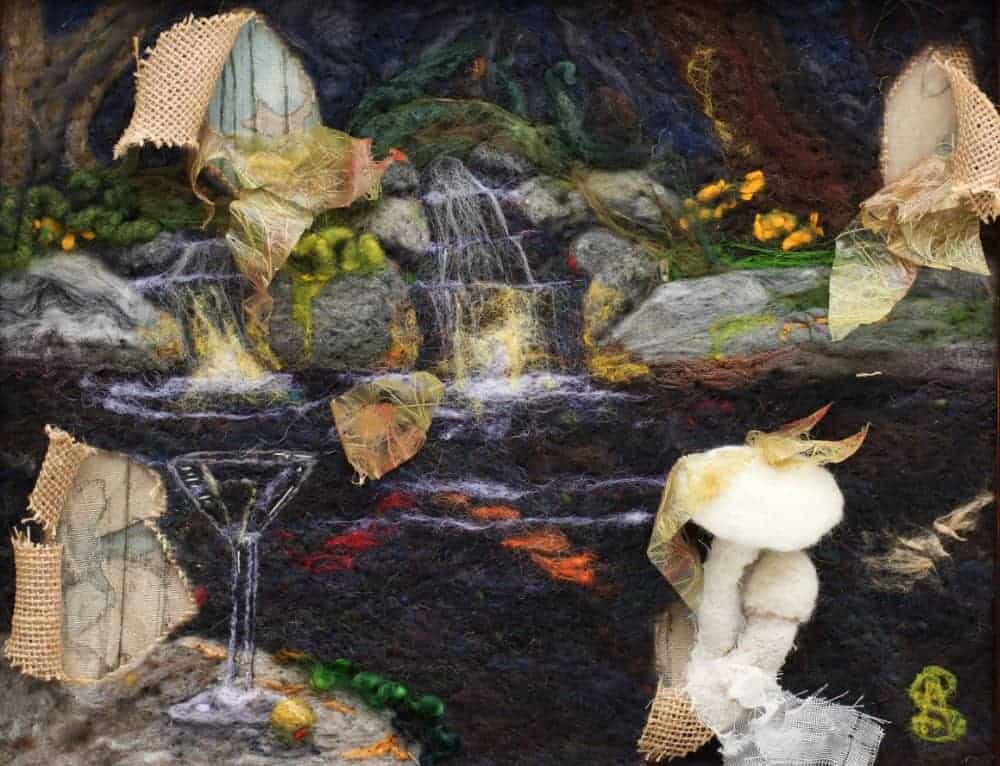
So what is sheep wool used for? Now you know 53 answers! I’m sure there are more things you can do with wool as well. What is surprising is how often sheep farmers, like the young fella and his family who came to my guild, find themselves with fleeces that largely go unused relative to their quality.
I was told once there was a time when there was no buyer for any of the commercially grown wool from meat production sheep breeds in New Hampshire. I haven’t taken the time to suss out the truth about that, but I am aware that a fair bit of US wool has gone unused year after year. The wool industry is something I’m only just starting to learn about. Given the many uses of wool fiber it is a curious thing. But discussing the state of the US wool market is a post for another day.
Would you like to see more of my writing? Try a story snack or a poem. Both are low-calorie and good for the heart. Coming to the Eastern TN area? Check out my directory of fiber art attractions.
Like this writing and want to see more? Your donation will help me maintain and expand this site.
References
Blog. thefeltstore.com. (n.d.). https://thefeltstore.com/blogs/news
Faisal Allafi, Md Sohrab Hossain, Japareng Lalung, Marwan Shaah, Ali Salehabadi, Mardiana Idayu Ahmad & Abdulbaki Shadi (2022) Advancements in Applications of Natural Wool Fiber: Review, Journal of Natural Fibers, 19:2, 497-512, DOI: 10.1080/15440478.2020.1745128
Fire resistant clothing for military and firefighters. Woolmark. (2018, August 14). https://www.woolmark.com/industry/research/science-backs-wool-base-layers-for-first-responder-clothing/
Hart, P. (2017). Wool unraveling an American story of artisans and Innovation. Schiffer Publishing Ltd.
Jan Broda, A. Gawlowski, M. Rom & K. Kobiela-Mendrek (2023) Utilisation of waste wool from mountain sheep as fertilizer in winter wheat cultivation, Journal of Natural Fibers, 20:2, DOI: 10.1080/15440478.2023.2200047
Singh Dhaliwal, J. (2020). Natural fibers: Applications. Generation, Development and Modifications of Natural Fibers. https://doi.org/10.5772/intechopen.86884
W., B. E. J. (1992). Prehistoric textiles: The development of cloth in the Neolithic and bronze ages with special reference to the Aegean. Princeton University Press.
Wilkes, S. (2018). Raw material: Working Wool in the West. Oregon State University Press.
